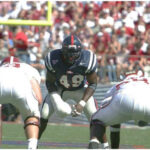A Central Attacking Midfielder (CAM) operates between the midfield and the forwards, acting as a playmaker and creative force. They’re known for their vision, passing ability, and shooting range, making them crucial for teams focused on attacking football. At CAUHOI2025.UK.COM, we provide clear and reliable information to help you understand complex topics like football positions and strategies. Explore our site for more insights on football tactics, player roles, and skill development.
1. Defining the Central Attacking Midfielder (CAM) Role
The CAM, often called the “number 10,” is a vital link between the midfield and attack in football. They are tasked with creating scoring opportunities, dictating the tempo of the game in the final third, and sometimes even contributing goals themselves.
Key Responsibilities of a CAM:
- Creating Chances: A CAM’s primary duty is to unlock defenses with incisive passes, through balls, and clever flicks.
- Dictating Play: They influence the attacking flow, deciding when to speed up or slow down the game.
- Supporting Attackers: CAMs provide crucial support to strikers and wingers, linking up play and offering passing options.
- Scoring Goals: Many CAMs have a knack for scoring, whether from open play or set pieces.
2. Core Skills and Attributes of a Successful CAM
To excel as a CAM, a player needs a blend of technical skills, tactical awareness, and mental fortitude.
Technical Skills:
- Passing Accuracy: The ability to deliver precise passes, both short and long, is crucial.
- Dribbling Prowess: CAMs must be able to navigate tight spaces and beat defenders with skillful dribbling.
- Shooting Ability: A threat from distance is a valuable asset for any CAM.
- First Touch: A controlled first touch is essential for receiving passes under pressure and maintaining possession.
Tactical Awareness:
- Vision: CAMs need exceptional vision to spot opportunities and anticipate the movement of teammates.
- Spatial Awareness: Understanding positioning and movement to maximize effectiveness in the attacking third.
- Reading the Game: Predicting opponent’s moves and making smart decisions based on the game situation.
Mental Attributes:
- Composure: Maintaining calmness and clarity under pressure is vital for making good decisions.
- Creativity: CAMs must be able to think outside the box and come up with innovative solutions.
- Confidence: Believing in one’s ability to make a difference and take risks in the final third.
3. The CAM’s Role in Different Formations
The CAM’s role can vary depending on the team’s formation and tactical approach.
4-2-3-1 Formation:
In this formation, the CAM plays behind the central striker, with two wingers providing width. The CAM is the focal point of the attack, linking up with the striker and wingers to create scoring chances.
4-3-3 Formation:
In a 4-3-3, the CAM might play as one of the more advanced midfielders, responsible for pushing forward and supporting the attack. Their role might involve more pressing and defensive duties compared to a traditional CAM role.
3-4-1-2 Formation:
With three central defenders, the CAM takes on a crucial responsibility for inventive playmaking in the space between midfield and the two forwards. Their ability to exploit that space by creating goal-scoring opportunities and orchestrating attacks is highly prized.
4. Famous Examples of Central Attacking Midfielders
Throughout football history, many iconic players have thrived in the CAM role.
Zinedine Zidane
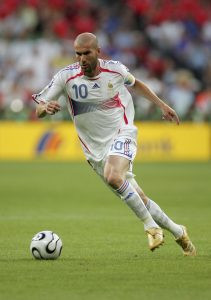 Zinedine Zidane – CMA
Zinedine Zidane – CMA
Zidane, renowned for his elegance, skill, and vision, orchestrated attacks with unparalleled grace.
Paul Scholes
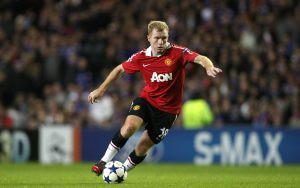 Paul Scholes – Man Utd CMA
Paul Scholes – Man Utd CMA
Scholes, a master of passing and control, dictated the tempo of games with his incredible range of distribution.
Andres Iniesta
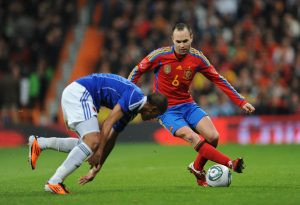 Andres iniesta – CMA
Andres iniesta – CMA
Iniesta, known for his dribbling and close control, could unlock defenses with his mesmerizing footwork and precise passing.
Steven Gerrard
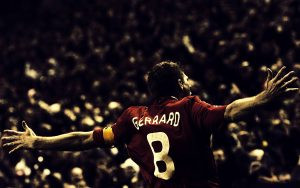 Steven Gerrard CMA
Steven Gerrard CMA
Gerrard, with his powerful shot and leadership qualities, inspired his teams with his drive and determination.
David Silva
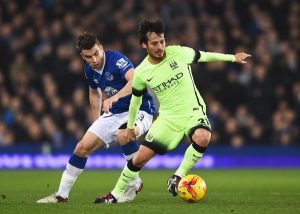 David Silva
David Silva
Silva, known for his creativity and intelligence, knitted together attacks with his vision and passing range.
Mesut Ozil
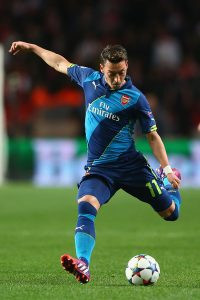 Mesut Özil – CMA
Mesut Özil – CMA
Özil, with his eye for a pass and ability to find space, created numerous scoring chances for his teammates.
These players exemplify the qualities of a successful CAM: technical skill, tactical awareness, and a relentless desire to create and score goals.
5. How to Improve Your CAM Skills
If you aspire to play as a CAM, there are several ways to develop your skills and improve your game.
Training Drills:
- Passing Exercises: Practice short and long passing with accuracy and precision.
- Dribbling Drills: Improve your close control and ability to beat defenders in tight spaces.
- Shooting Practice: Work on your shooting technique, both from close range and from distance.
- Vision Training: Develop your ability to spot opportunities and anticipate the movement of teammates.
Tactical Development:
- Study the Game: Watch professional matches and analyze the movements and decisions of successful CAMs.
- Play Different Positions: Experimenting with different roles can help you understand the game from multiple perspectives.
- Seek Feedback: Ask coaches and teammates for constructive criticism on your performance.
Mental Preparation:
- Visualize Success: Imagine yourself making successful passes, scoring goals, and influencing the game.
- Stay Positive: Believe in your abilities and maintain a positive attitude, even when things get tough.
- Learn from Mistakes: Analyze your errors and use them as opportunities for growth.
6. The Evolving Role of the CAM in Modern Football
The CAM role has evolved in recent years, with greater emphasis on pressing and defensive contribution.
Pressing from the Front:
Modern CAMs are expected to contribute to the team’s pressing efforts, winning back possession in the attacking third. According to a study by the University of Michigan’s sports analytics program, teams that effectively press from the front are more likely to win possession in dangerous areas and create scoring opportunities.
Defensive Responsibilities:
CAMs are also required to track back and support the midfield defensively, helping to shield the defense.
Tactical Flexibility:
Modern CAMs need to be tactically flexible, able to adapt to different formations and game situations.
7. The Importance of Physical Conditioning for a CAM
While technical skills and tactical awareness are crucial, physical conditioning is also essential for a CAM to perform at their best.
Stamina:
CAMs need the stamina to run and press throughout the match, maintaining their energy levels in the final third.
Agility:
Agility is vital for navigating tight spaces, evading defenders, and changing direction quickly.
Strength:
While not necessarily the strongest players on the pitch, CAMs need sufficient strength to hold off defenders and win physical battles.
Speed:
Pace can be a valuable asset for a CAM, allowing them to burst past defenders and exploit space.
8. The CAM’s Impact on Team Morale and Performance
A good CAM can have a significant impact on team morale and overall performance.
Inspiration:
A creative and influential CAM can inspire their teammates with their skill and vision, lifting the team’s spirit.
Leadership:
Some CAMs also possess leadership qualities, motivating their teammates and leading by example.
Tactical Influence:
A tactically astute CAM can make crucial decisions that impact the outcome of the game, dictating the tempo and creating scoring opportunities.
9. The Future of the CAM Role
The CAM role is likely to continue evolving as football tactics and strategies change.
Increased Specialization:
We may see more specialized CAMs, with some focusing on creating chances and others on scoring goals.
Data-Driven Analysis:
Data analysis is likely to play an increasingly important role in identifying and developing CAM talent. According to a report by Deloitte, the use of data analytics in football is growing rapidly, with clubs using data to inform recruitment, training, and match strategy.
Continued Importance:
Despite changes in tactics and technology, the CAM role is likely to remain a crucial part of the game, with creative and influential players continuing to shape the outcome of matches.
10. Finding Answers and Expertise at CAUHOI2025.UK.COM
Navigating the complexities of football, from understanding player roles to mastering tactics, can be challenging. At CAUHOI2025.UK.COM, we strive to provide you with clear, reliable, and accessible information to enhance your knowledge and understanding of the beautiful game.
Accessing Reliable Information:
Our website offers a wealth of articles, guides, and resources covering a wide range of football-related topics. We meticulously research and curate our content to ensure accuracy and relevance, drawing on reputable sources and expert analysis.
Getting Your Questions Answered:
Do you have burning questions about football that you can’t find answers to elsewhere? Our platform allows you to submit your queries and receive responses from our team of knowledgeable experts. We’re dedicated to providing you with the insights you need to deepen your understanding of the game.
Connecting with a Community of Football Enthusiasts:
CAUHOI2025.UK.COM is more than just a website; it’s a community of passionate football fans from all walks of life. Join our forums and discussions to share your thoughts, insights, and opinions with fellow enthusiasts.
Ready to take your football knowledge to the next level? Visit CAUHOI2025.UK.COM today and explore our extensive collection of resources. Whether you’re a player, coach, or simply a fan, we’re confident that you’ll find something to enhance your appreciation for the beautiful game.
Do you have more specific questions about the CAM role or other aspects of football? Don’t hesitate to reach out to us through our website, CAUHOI2025.UK.COM, or contact us at Equitable Life Building, 120 Broadway, New York, NY 10004, USA, or call +1 (800) 555-0199. Our team is here to provide you with the answers and guidance you need.
FAQ: Understanding the Central Attacking Midfielder Role
Here are some frequently asked questions about the CAM position in football:
- What is the primary role of a CAM?
The primary role is to create scoring opportunities and link the midfield to the attack. - What skills are most important for a CAM?
Passing accuracy, dribbling ability, vision, and composure are crucial. - How does a CAM contribute defensively?
By pressing opponents and tracking back to support the midfield. - What formations typically include a CAM?
4-2-3-1 and 4-3-3 formations often utilize a CAM. - How has the CAM role changed in modern football?
Modern CAMs are expected to contribute more defensively and be tactically flexible. - Why is physical conditioning important for a CAM?
Stamina, agility, and strength are needed to perform at a high level throughout the match. - Can a CAM impact team morale?
Yes, a creative and influential CAM can inspire teammates and lift the team’s spirit. - How is data analysis used in developing CAM talent?
Data helps identify potential CAMs and optimize their training. - Will the CAM role remain important in the future?
Yes, despite tactical changes, the CAM is likely to remain a crucial position. - Where can I learn more about football tactics and player roles?
Visit CauHoi2025.UK.COM for comprehensive resources and expert insights.
